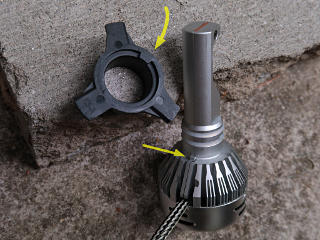
The two LED chips themselves are hidden under the aluminum flange in this and the next shot, but are visible later.
|
With LED automotive lighting rapidly taking over the mainstream, it seems
silly that a car would still have haolgen-lamp headlights, especially a
car geared toward overall energy efficiency.
Factory LED headlights are offered in the Kona's higher trim levels but
not in the SEL for some reason.
Nonetheless, why burn 2 x 55 watts when we could be using a quarter of
that?
Regardless of the fact that it's down in the noise relative to the energy
it takes to push the vehicle around, we have principles, and options
to explore.
LED output and packaging has reached a point that there are now numerous
offerings of modules that can fit into stock headlamp assemblies, emulate
something close to a bulb filament, and deliver similar or even better
light to the road.
In the mad rush to market, however, many seem to carry disfavorable reviews,
describing how hard they were to fit and install, bad beam patterns, running
too hot with premature failure, and numerous other problems.
One type seemed to come out near the top, and was also favorably described in the Kona forums -- a supposedly plug-n-play offering from LASFIT. I decided to take a plunge and give this one a try. A nicely packaged pair of modules arrived from Amazon a few days later. They clearly incorporated the two major design hallmarks emphasized by the Headlight Revolution folks -- fairly small emitter areas in the right position, and fan-cooled. |
| So I needed to go find a wall with clear area in front of it, where I could park a good distance away and aim the car straight toward it. For this test I installed ONE of the modules and left the other side with its original halogen, to compare the two throws at a distance, and went tooling off into the gathering evening to find a suitable test spot. This took a bit of searching around, as many buildings have obstructions between their surrounding pavement or are built on a bit of a rise above parking-lot level. What I found wasn't totally optimal -- the side of some industrial warehouse with a surrounding lawn I could pull a short way onto, but it would do for a first approximation. |
_H* 200910